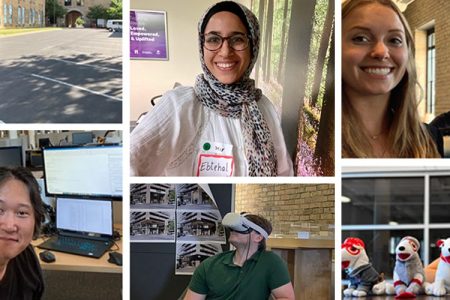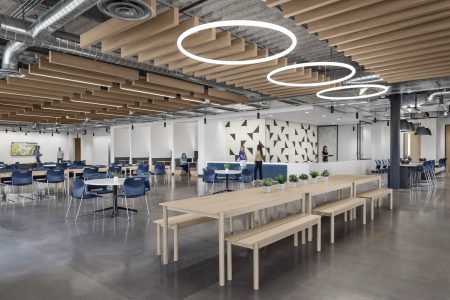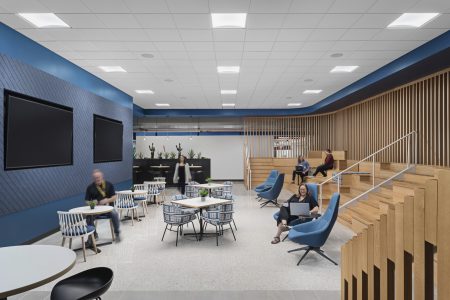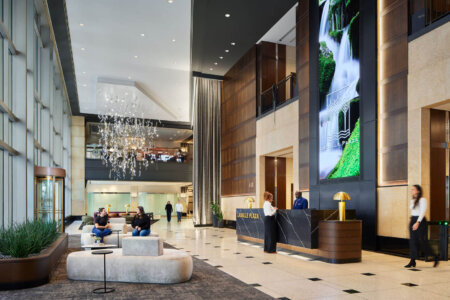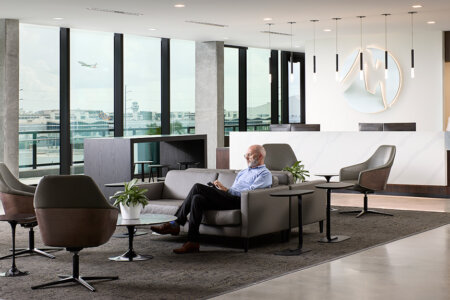5 Ways Workplaces and Workplace Designers are Adapting to Gen Z
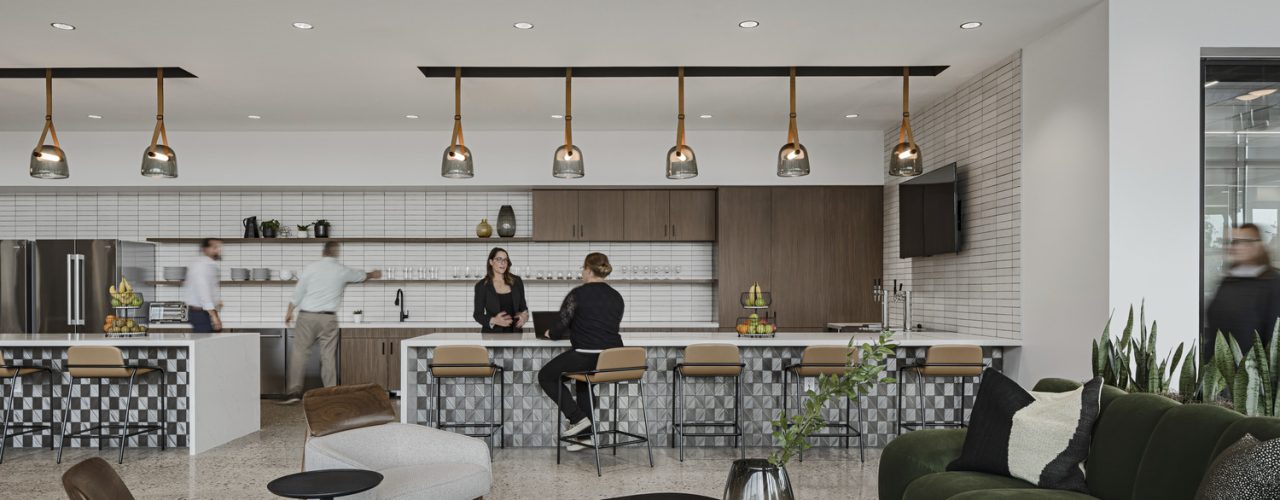
Now that Gen Z makes up a sizeable portion of the workforce, RSP’s Shanti Okawa explains five major ways they’re making their mark on the corporate workplace.
This article was originally published in Work Design Magazine.
Gen Z is making their mark on the office in a big way. They are challenging norms and pushing boundaries, and the savviest companies are making smart policy and design choices to keep them engaged.
With that said, although Gen Z is influencing the workplace, the office is also changing as a collective consequence of world events, shifting markets and up to five generations co-existing in the office at the same time. Through the clients I’ve worked with and the projects I’ve designed, I’ve noticed these five ways the office is changing as Gen Z continues to make up a more and more sustantial part of the workforce. And as a Zillennial myself, sandwiched between the Millennials and the Gen Zers, I have my own lived experiences to draw on as well.
1. The Office as a Social and Mentorship Hub
It’s not just younger 20-somethings who have a strong preference for working from home—in fact, Millennials are the most likely generation to say remote work is important to them, with 98% of workers saying they want to work remotely at least some of the time, according to Forbes. At the same time, there is a greater realization among employees and employers that culture and collaboration are suffering with 100% remote work, and for that reason we are seeing more of a hybrid return to work schedule. The physical office now has changed its purpose from being a place simply where work is completed to a place for mentorship, collaboration, and culture.
Crucially, the hierarchy of office spaces has changed. We now have a priority for prominent collaboration space and work cafés—places people can sit and talk with accessible power nearly everywhere. It’s the idea of a true hub where people can have flexibility, choice, and various interactions, while de-emphasizing workstations as people spend their time doing heads-down, focused work at home. It does take some work from the administrative and change-management side, but as designers, this is really where we see the office going and staying.
At JLL’s headquarters in Phoenix, our team created a central work café connecting to a social lobby area with meeting spaces surrounding it. We took open office space to the perimeter. The client wanted to cut down on the number of full-time, permanent workstations and the number of private offices while prioritizing social space and more culture-forward areas. We are seeing more and more organizations heading in the same direction and as designers and employees, we think it offers the best of both worlds for everyone.
2. Transparency is Crucial
Generally speaking, Gen Z is pretty cynical. That can be potentially frustrating, but it can also lead to the kind of pointed questions and feedback that can propel an organization into growth and future relevance. That’s why transparency is critical for engaging this younger generation of workers. They are not a silent workforce. Gen Z’ers are used to advocating for themselves and others and are not afraid to disrupt the status quo if it means social equity, diversity and inclusivity. A pleasing statement on a company website is not sufficient—they want tangible metrics to back up any claims of social or environmental responsibility.
As designers, we want to help our clients create a visual culture that matches who they are. Diversity, equity and inclusion are major topics for Gen Z and they want to see clear evidence of a culture reflecting those values. That means physical accessibility, using technology and design to help people reach their full potential, making sure everyone’s voice is heard, and helping employees understand that they and their work are meaningful to the organization.
In one large study by McKinsey, the two biggest reasons people 18-24 left their jobs were lack of career advancement and lack of meaningful work. That speaks volumes about what managers and companies need to do to keep these employees engaged and on the payroll. This comes down to organizational and management values, but the design of an office can make a major difference in creating spaces where people feel comfortable collaborating and raising important questions to keep companies transparent and honest.
3. Inclusivity in All Its Forms
The Americans with Disabilities Act was passed in 1990 and it permanently altered how we design office spaces to accommodate people with physical differences. Gen Z is going beyond physical accessibility to become the first generation that talks openly and confidently about neurological differences both in school and in the workplace. They are destigmatizing widespread variations like ADHD, sensory challenges and being on the autism spectrum. Through social media, humor, and open conversation, they are trying to create a world where people can be celebrated for their differences and the strengths they bring to the table.
Since starting my design career, one of my big focuses has been inclusive design and pushing the practice of participatory design—I want to design with people, not for them. In my process, I try to include as many different typologies and demographics as possible, from programming through construction. When designing offices for people with all kinds of different needs and work styles, I want to get input from underrepresented populations of employees as much as possible.
One of the most basic principles in designing for inclusivity is the idea that designing a space to support the specific needs of the minority will result in a space that also inherently benefits the majority. For example, things like quiet rooms for heads-down work, white noise in an open seating plan, unisex restrooms, and height adjustable desks aren’t strictly necessary for most employees to do their work in a productive way. But they mean the world to people who do need them and are just good design for the people who don’t.
4. Moving at the Speed of Technology
Some people disparagingly refer to Gen Z as the “iPad Generation.” That’s pretty reductive and unfairly labels a generation that has shown resilience, activism and acumen in the face of unprecedented social challenges. At the same time, it is true that people under 25 have had super-fast, touchscreen technology with an extremely user-friendly interface since they were children. They don’t remember a time before ubiquitous high-speed internet. In some ways, they are less adaptable than Millennials and Gen X when it comes to new programs and technology, especially some of the cumbersome software that many companies still rely on for day-to-day tasks. Whereas Millennials and Gen X saw the rise of personal technology and, for a certain age group, had to learn the basics of html to create a spectacular MySpace page and file sharing to burn CDs. Gen Z has had streamlined technology their whole lives.
Management may be surprised to learn that Gen Z needs training when it comes to technology, but it’s also a great opportunity to build community and culture. When more experienced employees can teach through a position of true expertise, they become mentors and have the chance to pass on their philosophy to newer workers. In turn, Gen Z has the opportunity for meaningful knowledge sharing and career growth. Yes, it’s possible to do this type of training online at home. But I would argue that this kind of training is one of the best uses of the “office as a social hub” to encourage connections across generations.
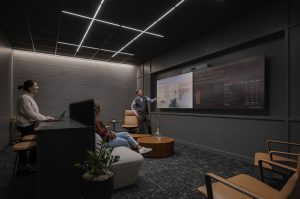
Speaking of technology, we’re also seeing the potential of AI to be used in more and more applications. Gen Z has started to embrace it as a tool for creativity and inspiration, as well as something that can help save time and increase productivity. They are also savvy enough to see some of the dangers inherent in adopting AI without regulations. Time will tell how tools like AI will begin to affect the corporate world but, again, new technology is a great opportunity for different generations to have their voices heard and collaborate on standards and solutions.
5. The Power of Instant Gratification
Lastly, one of the hallmarks of Gen Z compared to other generations is the expectation of instant gratification. Frequent reviews and feedback keep them engaged and organizations need the infrastructure, technology and offices to support that. Perks, rewards and wellness programs are also great incentives to retain these younger employees.
These ideas, from programs to design choices, may feel disruptive and may initially be implemented to satisfy Gen Z, but in the end, all employees may find that they appreciate them. And that can only make for a more engaged, happier, more productive workforce.
About Shanti Okawa
Having started at RSP as an intern while attending ASU, Shanti Okawa has rapidly become an integral and invaluable part of the interior design team. In a few short years, she has grown into an accomplished Project Interior Designer in the Phoenix office, now taking a leading role in complex interiors projects, from the earliest interview stages to programming, design and Construction Documents to Construction Administration and final site walkthroughs. She is the leading Equity, Diversity and Inclusion (EDI) advocate in RSP’s Phoenix office, always pushing colleagues and clients to think more broadly about opportunities to enhance inclusivity in new ways. Read more about Shanti on LinkedIn.
Featured Image: JLL Headquarters, Phoenix, AZ | Image Credit: Roehner + Ryan


